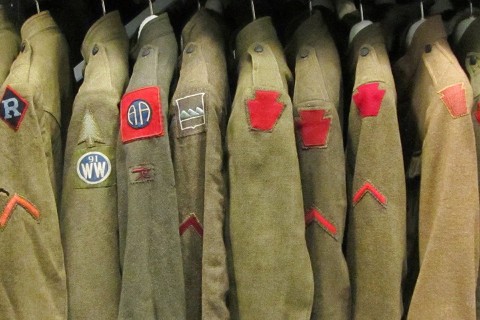From the streets of SoHo to the runways in Paris, embroidered patches are undeniably having a moment in today’s fashion world. Given the boom of fast-fashion and mass produced garments, consumers are seeking new ways to stand out—and that desire has paved the way for this generation of up-and-coming designers to re-energize the once-stagnant world of patches.
Even Alessandro Michele and the iconic fashion house Gucci have incorporated embroidered motifs in recent seasons—most noticeably in a standout collection that has caught the eyes of fashionable dudes like A$AP Rocky and 2 Chainz, and produced what could be the jacket of the year. However, patches weren’t always intended to take your outfit to the next level. In fact, it took years for the humble patch to evolve from utility to accessory.
The United States military began mass-producing official division patches in the early 19th century. Shortly after, the rest of the country followed suit. Everyone was getting in on the action: factory workers, delivery men, police and fire departments—you name it. The patch soon became an everyday occurrence in American culture. While it was originally an icon of the working class, the embroidered look would eventually find a new home within the counterculture.
Patches were everywhere the mainstream wasn’t: the rise of biker culture in the ’60s, the hippie movement of the ’70s, the birth of punk rock in the ’80s. The embroidered patch was a staple within each of these worlds. It symbolized individualism and a rebellious spirit, and was a way of showing you didn’t conform to society’s standards.
You wore your heart on your sleeve—literally. The patch would have a steady presence in the aesthetic of the underground for decades to come before making its way into the mainstream fashion. But, before we explore what’s happening in patches today, let’s take a step back and explore where it all started.

Gucci
The exact origins of embroidery aren’t crystal clear but it’s estimated to have first appeared in ancient China, way back in the 3rd century BC. The process was originally used to serve a functional purpose—to patch and mend clothing.
As time went on, some creative seamstresses decided to step up their embroidery game and evolve the form to a means of decorative expression. Once that happened, embroidery would slowly make its way all over the globe.
As the craft reached different cultures, it changed from a way to personalize clothing and transformed into art that proudly hung in the wealthy homes. The designs would eventually become smaller, more intricate and start to resemble what we now recognize as the modern embroidered patch.
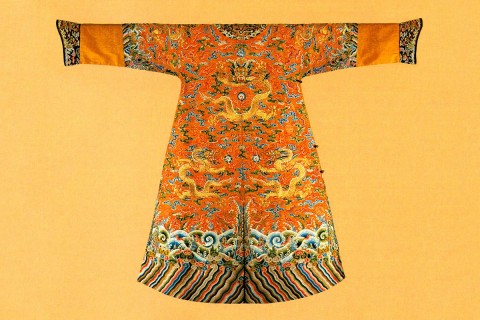
art of silk
Back then, all patches were created by hand—a painstakingly slow process, to say the least. First, the main fabric was cut to shape and heat-sealed to prevent fraying. Then, the design was stitched into place with thread. While relatively simple, it was still extremely time consuming.
The big turning point in embroidery came during the Industrial Revolution. In 1863, a Swiss inventor by the name of Isaac Gröbli changed the game with the Schiffi embroidery machine. While the technology and materials used to create modern machines has improved since then, the process remains virtually the same.
Armed with slick new machinery, the reach of the embroidered patch would soon explode—and eventually lead us to the new class of designers and brands currently keeping the patch dream alive.
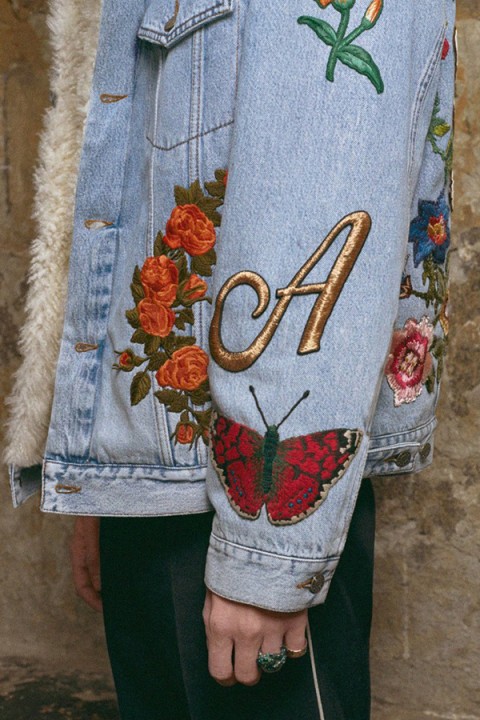
Gucci
The resurgence of the patch is pretty diverse. At one end you have those who have made it their side hustle, releasing goods when they find the time while other designers have made the craft their livelihood. Maurice Blanco is a perfect example of the former. Blanco pays the bills as a designer for streetwear label Mishka and runs Tough Times Press with his girlfriend Danielle during nights and weekends.
The duo definitely knows how to tap into pop-culture, a common theme in the recent boom of patches and pins. Early on they combined The Misfits’ iconic The Crimson Ghost skull with Raphael of Teenage Mutant Ninja Turtles, and the design took off. Then came a Wu-Tang x Hello Kitty mash-up and “Peace To All My Haters” patch, which slowly turned their fun project into a fledgling brand.
“This is totally just something on the side I do for now,” Blanco told Highsnobiety, “But it will hopefully become a full time thing.” That’s part of the beauty of patches and accessories: They’re relatively inexpensive to produce, which means young designers can experiment with new ideas without a huge monetary risk at their own pace.
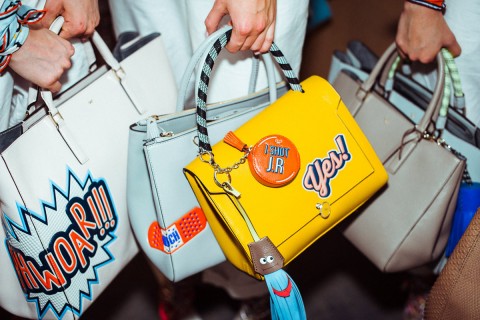
thesnobette
Ball & Chain Co. is a perfect example of a fully-formed brand who was birthed by the patch. The label, who has since expanded their offering to include flags, pins and a full cut ‘n sew program, has amassed over 57 thousand followers on Instagram and nabbed features in the likes of Vogue and Interview—just in their first year.
After starting the company with only a single patch design (it was “just a rose that said Fuck Forever,” notes founder Thomas Woodie) the brand is now shipping over a 1,000 orders a week with no signs of slowing down.
Ball & Chain Co. quickly grew from a small side project to a full-time gig once the internet discovered the brand’s sharp wit and provocative style. It’s not just brands like Ball & Chain Co and Tough Times Press, even designer labels have jumped on the trend.
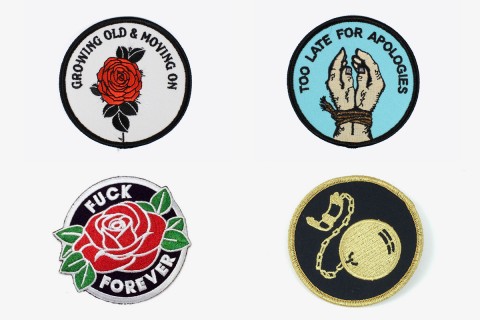
Ball & Chain Co.
Revered brands like OFF-WHITE c/o Virgil Abloh and Tim Coppens have embraced the patch as part of their “downtown cool meets high-end” vibe, using embroidered patches throughout recent collections. Designer Anya Hindmarch has built an accessories empire (generating close to $60M USD in annual revenue) based off her quirky embossed and embroidered style.
The Spring 2017 collection from Ovadia & Sons featured a number pieces with elaborate embellishments, including a standout rose embroidered souvenir jacket. Perhaps the most visible adoption of the look in the high-fashion world has been from Alessandro Michele and Gucci. The emerging creative director created a collection of silk bombers, denim jackets and accessories featuring a variety of embroidered snakes, tigers and flowers.
Then, like any luxury designer aesthetic that really hits, it was blatantly ripped off by global retail giant Topman.
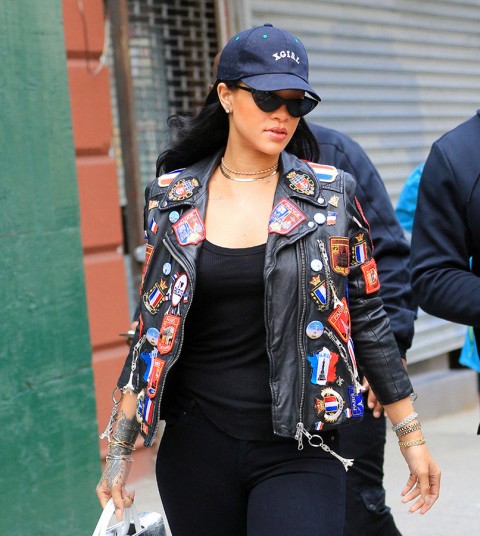
Splash
Don’t be mistaken by all the mainstream attention though—embroidered patches still, and will always, have their place in the outskirts of culture. You’ll still see metal heads pledging allegiance to underground bands and badass bikers representing their club via the classic patch.
But, for now, patches have become a reflection of the mainstream zeitgeist. Whether it’s referencing pop culture’s latest fad or the internet’s funniest meme, being on the pulse of what’s trending is often the way to go. ’90s nostalgia? Check. Crying Jordan face? You got it.
The ability to play off current cultural themes has opened the doors for designers and brands alike to find quick success by tapping into that popularity and adding a clever twist. In turn, this has allowed consumers to to add the personal touch to their outfits that they craved.

David M Benett/ Getty Images
It’s hard to tell if the influx of embroidered patches is just passing trend or here to stay, but the medium has certainly allowed an entire generation of designers and fashionable entrepreneurs alike to make name for themselves. And that’s not half bad, considering the patch used to be the furthest thing from fashion.
Now check out our exploration of how Gucci is championing outsider spirit on the runway.
-
Words:
Tyler Watamanuk -
Lead image:
Tim Suen

